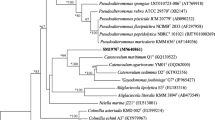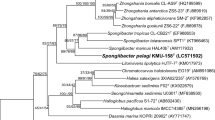Abstract
The phenotypic and carrageenolytic features of a novel halo tolerant marine bacterium, isolated from decayed red algal samples collected along the west coast of India were studied. This gram-negative strain was identified asPseudomonas elongala (MTCC 5261) syn.Microbulbifer elongalus comb. nov according to its morphological, physiological and molecular characterization. The extracellular κ-carrageenase was purified 106.54-fold by a combination of ammonium sulfate precipitation (40∼60%) and successive gel filtration chromatography. The purified protein fraction yielded significantly high activity of 426.19 units/mg protein and migrated as a single band on a sodium dodecyl sulfate polyacrylamide gel electrophoresis with a molecular weight of ∼128 kDa. For κ-carrageenase activity, optimum temperature was 40°C whereas two pH optimai.e. 5.6 and 7.7 were observed. For κ-carrageenan, the enzyme gave aK m value of 6.66 mg/mL and aV max value of 4 μmol/min/mg when the reaction was carried out at 40°C and pH 5.6. Isolated κ-carrageenase could successfully generate protoplasts ofKappaphycus alvarezii. This is the first report on the production of κ-carrageenase by this bacterium isolated from west coast of India. Molecular mass and various characteristics showed that the carrageenase fromP. elongata was much different from those previously reported.
Similar content being viewed by others
References
Antonopoulos, A., P. Favetta, W. Helbert, and M. Lafosse (2005) On-line liquid chromatography electrospray ionization mass spectrometry for the characterization of κ- andi-carrageenans. Application to the hybridt-/V-carrageenans.Anal. Chem. 77: 4125–4136.
Le Gall, Y., J. P. Braud, and B. Kloareg (1990) Protoplast production inChondrus crispus gametophytes (gigartinales, rhodophyta).Plant Cell Rep. 8: 582–585.
Ostgaard, K., B. F. Wangen, S. H. Knutsen, and I. M. Aasen (1993) Large-scale production and purification of κ-carrageenase fromPseudomonas carrageenovora for applications in seaweed biotechnology.Enzyme Microb. Technol. 15: 326–333.
Dyrset, N., K. Q. Lystad, and D. W. Levine (1997) Development of a fermentation process for production of a κ-carrageenase fromPseudomonas carragecnovora.Enzyme Microb. Technol. 20: 418–423.
Michel, G., L. Chantalat, E. Duee, T. Barbeyron, B. Henrissat, B. Kloareg, and O. Dideberg (2001) The κ-carrageenase ofP. carrageenovora features a tunnel-shaped active site: a novel insight in the evolution of Clan-B glycoside hydrolase.Structure 9: 513–525.
Potin, P., A. Sanseau, Y. Le Gall, C. Rochas, and B. Kloareg (1991) Purification and characterization of a new κ-carrageenase from a marineCytophaga-like bacterium.Eur. J. Biochem. 201: 241–247.
Fleurence, J., L. Massiani, O. Guyader, and S. Mabeau (1995) Use of enzymatic cell wall degradation for improvement of protein extraction fromChondrus crispus. Gracilaria verrucosa andPalmaria palmata.J. Appl. Phycol. 7: 393–397.
Barbeyron, T., A. Gerard, P. Potin, B. Henrissat, and B. Kloareg (1998) The κ-carrageenase of the narine bacteriumCytophaga drobachiensis. Structural and phylogenetic relationships within family-16 glycoside hydrolases.Mol. Biol. Evol. 15: 528–537.
Barbeyron, T., B. Henrissat, and B. Kloareg (1994) The gene encoding the κ-carrageenase ofAlteromonas carrageenovora is related to β-1,3-1,4-glucanases.Gene 139: 105–109.
Potin, P., C. Richard, T. Barbeyron, B. Henrissat, C. Gey, Y. Petillot, E. Forest, O. Dideberg, C. Rochas, and B. Kloareg (1995) Processing and hydrolytic mechanism of thecgkA-encoded κ-carrageenase ofAlteromonas carrageenovora.Eur. J. Biochem. 228: 971–975.
Araki, T., Y. Higashimoto, and T. Morishita (1999) Purification and characterization of κ-carrageenase from a marine bacterium,Vibrio sp. CA-1004.Fish. Sci. 65: 937–942.
Barbeyron, T., G. Michel, P. Potin, B. Henrissat, and B. Kloareg (2000)t-Carrageenases constitute a novel family of glycoside hydrolayses, unrelated to that of κ-carrageenases.J. Biol. Chem. 275: 35499–35505.
Chency, D. P., E. Mar, N. Saga, and J. van der Meer (1986) Protoplast isolation and cell division in the agar-producing seaweedsGracilaria (Rhodophyta).J. Phycol. 22: 238–243.
Araki, T., T. Aoki, and M. Kitamikado (1987) Preparation and regeneration of protoplasts from wild type ofPorphyra yezoensis and green variant ofP. tenera.Nippon Suisan Gakkaishi 53: 1623–1627.
Araki, T., Z. Lu, and T. Morishita (1998) Optimization of parameters for isolation of protoplasts fromGracilaria verrucosa (Rhodophyta).J. Mar. Biotechnol. 6: 193–197.
Gross, W. (1990) Preparation of protoplasts from the carrageenophyteGigartina corymbifera (Kutz.) J. Ag. (Rhodophyta).J. Microbiol. Methods 12: 217–223.
Gall, E. A., Y. M. Ching, and B. Kloareg (1993) Isolation and regeneration of protoplasts fromPorphyra dentate andPorphyra crispata.Eur. J. Phycol. 28: 277–283.
Zablackis, E., V. Vreeland, and B. Kloareg (1993) Isolation of protoplasts fromKappaphycus alvarezii var.tambalang (Rhodophyta) and secretion of κ-carrageenan fragments by cultured cells.J. Exp. Bot. 44: 1515–1522.
Mollet, J. C., M. C. Verdus, R. Kling, and H. Morvan (1995) Improved protoplast yield cell wall regeneration inGracialria verrucosa (Huds.) Papenfuss (Gracilariales, Rhodophyta).J. Exp. Bot. 46: 239–247.
Yoon, J. H., H. Kim, K. H. Kook, T. K. Oh, and Y. H. Park (2003) Transfer ofPseudomonas elongata Humm 1946 to the genusMicrobulbifer asMicrobulbifer elongatus comb. nov.Int. J. Syst. Evol. Microbiol. 53: 1357–1361.
Khambhaty, Y. (2005)Studies on Seaweed Polysaccharide Degrading Enzymes from Marine Bacteria. Ph.D. Thesis. Bhavnagar University, Bhavnagar, India.
Khambhaty, Y., K. Mody, and B. Jha (2007) Method for the preparation of κ-carrageenase.US patent 2007-0231866.
Sneath, P. H. A. (1994) In: W. M. Hensyl (ed).Bergey's Manual of Systematic Bacteriology. ninth ed., Williams & Wilkins, Philadelphia, PA, USA.
Weisburg, W. G., S. M. Barns, D. A. Pelletier, and D. J. Lane (1991) 16S ribosomal DNA amplification for phylogenetic study.J. Bacteriol. 173: 697–703.
Khambhaty, Y., K. Mody, B. Jha, and V. Gohel (2007) Statistical optimization of medium components for κ-carrageenase production byPseudomonas elongata.Enzyme Microb. Technol. 40: 813–822.
Ghadi, S. C., U. D. Muraleedharan, and S. Jawaid (1997) Screening for agarolytic bacteria and development of a novel method forin situ detection of agarase.J. Mar. Biotechnol. 5: 194–200.
Nelson, N. (1944) A photometric adaptation of the Somogyii method for the determination of glucose.J. Biol. Chem. 153: 375–380.
Lowry, O. H., N. J. Rosebrough, A. L. Farr, and R. J. Randall (1951) Protein measurement with the Folin phenol reagent.J. Biol. Chem. 193: 265–275.
Bradford, M. M. (1976) A rapid and sensitive method for the quantitation of microgram quantities of protein utilizing the principle of protein-dye binding.Anal. Biochem. 72: 248–254.
Sambrook, J. and D. W. Russel (2001)Molecular Cloning: A Laboratory Manual. 3rd ed., Cold Spring Harbor Laboratory Press, Cold Spring Harbor, NY, USA
Lineweaver, H. and D. Bruk (1934) The determination of enzyme dissociation constants.J. Am. Chem. Soc. 56: 658–666.
McLean, M. W. and F. B. Williamson (1979) κ-Carrageenase fromPseudomonas carrageenovora.Eur. J. Biochem. 93: 553–558.
Sarwar, G., S. Matayoshi, and H. Oda (1987) Purification of κ-carrageenase from a marineCytophaga species.Microbiol. Immunol. 31: 869–877.
Johnston, K. H. and E. L. McCandless (1973) Enzymic hydrolysis of the potassium chloride soluble fraction of carrageenan: properties of λ-carrageenase fromPseudomonas carrageenovora.Can. J. Microbiol. 19: 779–788.
Salvador, R. and A. Serrano (2005) Isolation of protoplasts from tissue fragments of Philippine cultivars ofKappaphycus alvarezii (Solieriaceae. Rhodophyta).J. Appl. Phycol. 17: 15–22.
Author information
Authors and Affiliations
Corresponding author
Rights and permissions
About this article
Cite this article
Khambhaty, Y., Mody, K. & Jha, B. Purification and characterization of κ-carrageenase from a novel γ-proteobacterium,Pseudomonas elongata (MTCC 5261) syn.Microbulbifer elongatus comb. Nov.. Biotechnol. Bioprocess Eng. 12, 668–675 (2007). https://doi.org/10.1007/BF02931084
Issue Date:
DOI: https://doi.org/10.1007/BF02931084




